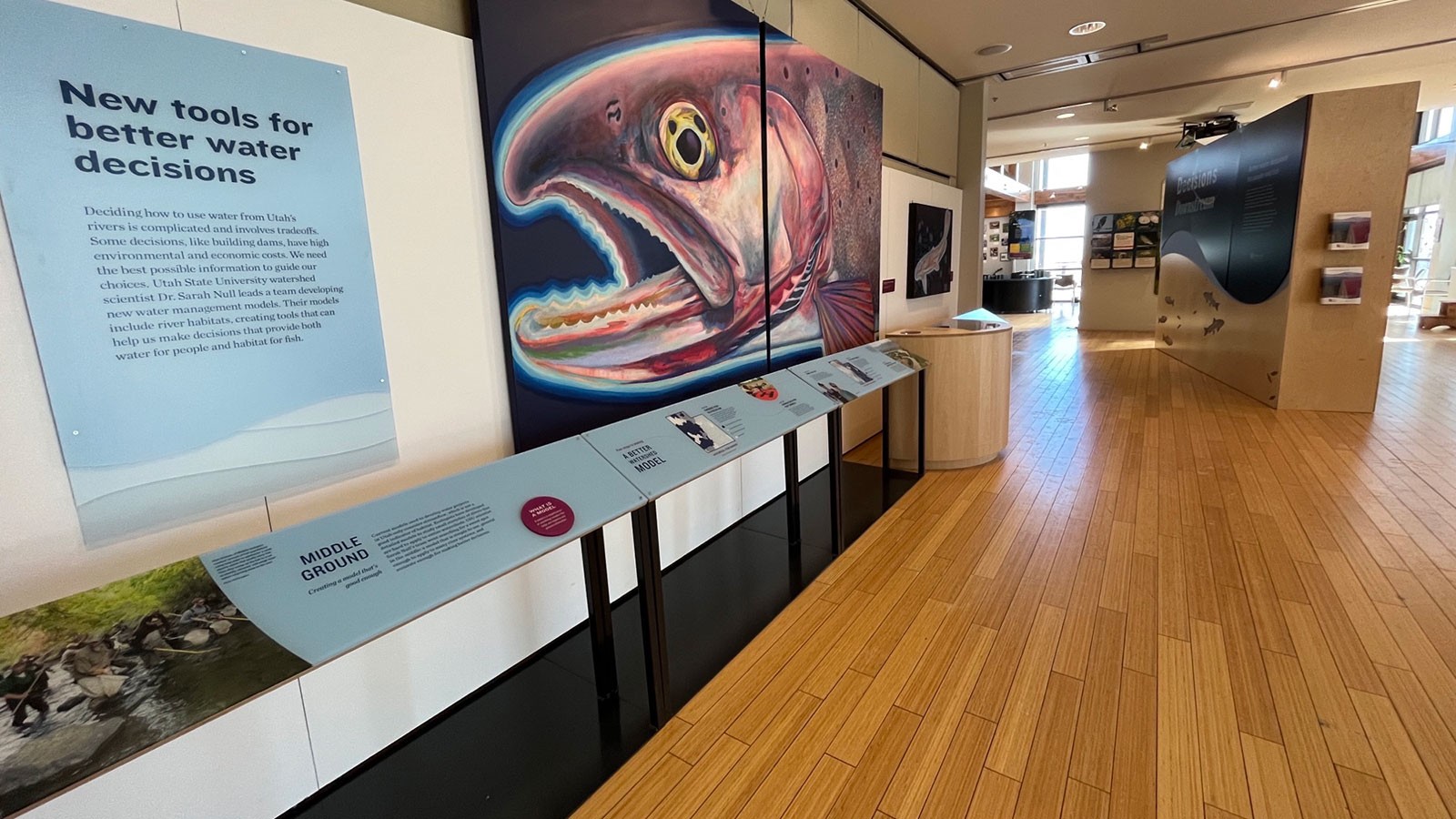Exhibit at Swaner EcoCenter Lets Public Dive Into Watershed Modeling
A colossal, prismatic mural sporting a cutthroat trout is not your typical academic research.
By Lael Gilbert |
The Decisions Downstream exhibit at the Swaner EcoCenter in Park City uses art and science to illustrate how management decisions about rivers could be improved by incorporating information about the ecosystem. (USU/Sarah Null)
A colossal, prismatic mural sporting a cutthroat trout is not your typical academic research, but Sarah Null thinks it more often should be.
In an interactive exhibit at the Swaner EcoCenter in Park City, Sarah Null and colleagues use art and accessible science to illustrate how decisions about river management can be improved by incorporating broader information about ecosystems. The Decisions Downstream exhibit kicks off with an in-person presentation from Null and artist Chris Peterson at 6 p.m. on March 29 and continues through May 29.
The goal of the exhibit is to illustrate how integrated models can be used to understand and manage water systems. For instance, when managers in Utah plan for projects like dams, they consider mainly information about streamflow (how much water moves past a certain point within a certain timeframe). But that doesn’t show the whole picture, said Null, an associate professor in the Department of Watershed Sciences and the Ecology Center.
On the other hand, ecologists are able to create detailed models of short stretches of river that include information on habitat, slope, water speed and more. But these aren’t always compatible with the regional scales needed to make decisions about water development projects.
Null and her team found ways to merge the two sets of information to create a model that is simple to use, general enough to apply to multiple river systems, and has enough detail to inform decisions on both utilitarian and ecological fronts. But digesting this kind of layered information can take effort, and Null wants to make it accessible to a wide audience. She recruited artists Chris Peterson and Carsten Meier to create large-format images and paintings based on her research.
“This exhibit highlights the beautiful mosaics of habitat created by rivers, some fish species native to Utah, and decisions about how to best manage water for people and the environment,” Null said. “It invites visitors to see rivers as diverse habitats and to think critically about the benefits of rivers that we wish to maintain for the future.”
The exhibit, funded by the National Science Foundation, USU’s Ecology Center, the Department of Watershed Sciences, and the S.J. & Jessie E. Quinney College of Natural Resources, focuses on Bonneville Cutthroat Trout and Bluehead Sucker, priority species for state agencies. After gathering on-the-ground information and testing multiple models designed to predict where fish habitat exists, the researchers found a sweet spot — they determined that stream temperature was key for identifying habitat for Bonneville Cutthroat Trout (although streamflow was important during summer), and slope best predicted Bluehead Sucker habitat. They worked with managers at state agencies to confirm what they observed on streams they managed.
These integrated models allow communities and resource managers to better understand the true impacts of their decisions about development projects on river ecosystems. They’ll be able to see how a proposed dam at one site might have much bigger impacts on fish habitat compared to another, not-too-distant site. The models have the potential to empower communities to make the best choices possible and maintain fish habitat, too.
WRITER
Lael Gilbert
Public Relations Specialist
Quinney College of Natural Resources
435-797-8455
lael.gilbert@usu.edu
CONTACT
Sarah Null
Associate Professor
Department of Watershed Sciences
435-797-1338
sarah.null@usu.edu
ADDITIONAL RESOURCES
TOPICS
Water 258stories Exhibitions 128stories Land Management 123storiesComments and questions regarding this article may be directed to the contact person listed on this page.







